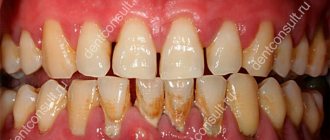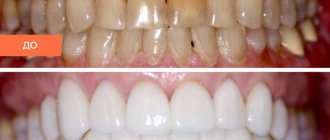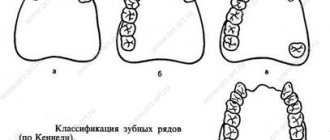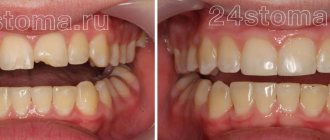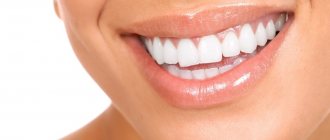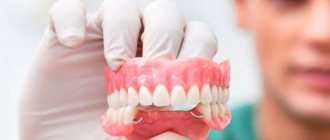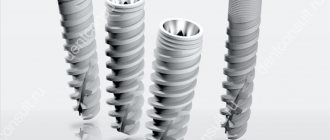Veneers are thin overlays, mainly made of ceramics, that are installed on the front surface of the tooth and the cutting edge. They are used to correct irregular shapes, hide chips and cracks, and eliminate excess gaps. But the most common reason why patients decide to have these miniature dentures installed is the desire to give their teeth a lighter and more even shade. Chemical whitening does not always give the desired effect and requires regular repetition, but veneers solve aesthetic problems comprehensively and for a long time.
How is the color of veneers determined?
To select the color of ceramic microprostheses, dentists use a special scale called Vita. It includes:
- 16 natural shades;
- 4 ultra-whites that practically do not exist in nature - Bleach.
Thus, you can choose the appropriate color from as many as 20 options. If the patient only needs a few restorations, the shade of the veneers should match the color of the adjacent teeth. However, if microprostheses are placed over the entire smile area, then the patient is free to choose any color he likes, based on his ideas about beauty and the doctor’s recommendations.
Naturally colored veneers according to the Vita scale are presented in the form of four blocks in accordance with the enamel undertone:
- A - red-brown;
- B - yellow-red;
- C - gray;
- D - gray-red.
There is no need to be alarmed: such a classification does not mean that the selected sample will be red or gray. Only a specialist will see the difference between the tone of ceramic veneers; for patients, they look approximately the same - like ordinary natural teeth.
Each of the four blocks contains four shades, grouped by brightness: from the lightest to the darkest. They are designated by the numbers 1, 2, 3 and 4. Accordingly, all tooth colors on the Vita scale have their own alphabetic and digital number - for example, a2 or b1.
Metal ceramics are inexpensive. How are dentures installed?
Installation of ceramic dentures occurs in several stages. First, the patient needs to make an appointment with the selected dentist, undergo diagnostics and dental treatment, if necessary. Also, a mandatory stage of prosthetics is a general diagnosis of the body and a study of the patient’s medical history at the time of identifying contraindications. The dentist then follows the following therapeutic plan:
- preparation of teeth for a crown (grinding down enamel, removing nerves);
- taking impressions from the received supports, according to which an individual orthodontic design will be made in the future;
- fitting of prostheses, their polishing and correction:
- installation of the structure.
On average, dental prosthetics with metal-ceramics at the A-Medic clinic takes about two weeks. Dentists draw the attention of patients to the fact that when choosing a ceramic design, a more gentle grinding of tooth enamel from the supporting tooth is performed. This is possible due to the small thickness of the ceramic coating. Metal-ceramic dental prosthetics does not require complete grinding of bone tissue, so the risk of irritation, swelling and allergies after inserting the prosthesis into the oral cavity is minimal.
The most popular colors of ceramic veneers
The standard for a beautiful smile is straight, light teeth that look natural. Aesthetic dentistry helps to achieve exactly this effect, so it is not surprising that the most popular shades on the Vita scale are considered to be the first numbers in tones A and B.
✔
Patients who want natural veneers are most often attracted to color a1 (photo). This is a light pearl shade, close in brightness to the Bleach range, but without artificial whiteness. This color is refreshing and, without exaggeration, rejuvenating, because, as we know, in our youth our teeth look much whiter.
✔
The color of A2 teeth is a little darker, but only a doctor can distinguish such veneers from natural teeth - those around you will be sure that your smile is so naturally beautiful.
✔
Another favorite tooth color for many is b1. It's just as light and bright as a1, but has a different tonality that will be preferable for certain skin tones.
For what reasons can the shade of teeth change?
A naturally perfect snow-white smile is quite rare. In addition to the fact that most people’s teeth have a slight yellowish tint from birth, throughout their lives they are constantly exposed to external factors that cause their color to change. Here are just the main prerequisites:
- improper and irregular cleaning,
- addiction to coffee, strong tea and other coloring drinks,
- smoking cigarettes,
- aging of the body,
- dental diseases,
- consumption of products with intense coloring pigments,
- lack of vitamins and microelements or their excess in the body,
- taking certain medications.
Constant exposure to external factors causes changes in the color of teeth
. To maintain the natural whiteness of a smile, you need to follow the rules of oral hygiene, respond in time to any suspicious changes, and regularly visit the dentist’s office for preventive examinations.
Bleach teeth color - Hollywood smile
No matter how much natural beauty is valued, many patients dream of a dazzling white smile, like that of movie stars. For such cases, the Vita palette includes four snow-white shades “Bleach”, which do not exist in nature.
Bleach 1 and Bleach 2 are bright white enamel with virtually no yellow pigment. Such shades are associated with shockingness and can only look good on stage, in the spotlight and against the backdrop of bright makeup. In shades Bleach 3 and Bleach 4 a small percentage of yellow pigment appears, but they still remain outside the natural palette.
The bleach color of ceramic veneers looks more appropriate on dark skin. Those with Northern European appearance are better off giving preference to natural shades a1 and b1 - they are just as light, but look more organic.
How the scale is used, subtleties of application
When conducting a comparative analysis, the dentist takes into account a large number of nuances. The assessment result is influenced by subjective factors that vary depending on lighting, the patient’s skin tone, and the general condition of the oral cavity.
The Vita tooth color scale is used to compare the color of different areas of the jaw structure. This is due to differences in the thickness of dentin tissue or enamel coating, uneven home cleaning, and the onset of the pathological process.
The dentist takes 3 measurements - near the gum bed, at the upper edge, in the central part of the tooth. Compare the shade on the front and back surfaces of the jaw element.
When an analysis is performed to make a denture, the results are sent to a dental laboratory. Designs are selected using a reference sample with the specified code - A2, C3 and so on.
When using a scale for laser or chemical whitening, the results obtained are compared during the process in order to achieve the most natural appearance of the oral cavity.
Colors of Emax ceramic veneers
Emax glass-ceramic microprostheses differ from conventional ceramic veneers in their manufacturing technology. Accordingly, for overlays of this type there is a separate color scale - Vita 3D-Master. Here, not two, but three color selection options are used.
- Brightness - from 1 to 5.
- The tonality is L (more yellow) and R (more red).
- Saturation - from M1 to M3.
To determine the shade of the future veneer, the doctor first determines its brightness, moving from the darkest to the lightest, then selects the intensity level M and, lastly, the tonality L or R. The color codes of the Vita 3D-Master palette consist of three symbols - for example, 3M2 .
Metal-ceramic teeth: prices for the service
Metal-ceramic prosthetics prices depend on many factors. In any case, such a crown is cheaper than one made from solid ceramics or with a zirconium base. The cost of a metal-ceramic tooth is determined precisely by the material used to make the structure. Dentists note that prosthetics with metal and ceramic crowns are considered the most budget-friendly option, while the quality and aesthetic properties of the prosthesis are no worse than those of other models.
Metal-ceramics installation cost at the A-Medic clinic includes:
- primary treatment of the tooth surface for a crown (dental treatment, if necessary, is paid separately);
- taking and making impressions;
- production of a permanent crown in the clinic laboratory;
- implantation by an orthopedist.
During your initial visit to a specialist’s office, the dentist will necessarily draw up a financial treatment plan. The patient will be offered several options to restore the aesthetics and function of the teeth. Metal-ceramics price allows you to perform effective oral treatment that does not go beyond the budget planned by the clinic client for treatment. You can make an appointment with an orthodontist by phone or on the clinic’s website at a time convenient for the patient. Consultations are provided free of charge.
What color of veneers should I choose?
A doctor will help you find the right shade for your restorations, ideally together with a dental technician.
If it is necessary to restore the aesthetics of individual teeth, the color of the onlays is selected in accordance with the shade of the “neighbors”. Before getting veneers, you may be recommended a whitening procedure to make your teeth 1-2 shades whiter and choose lighter veneers. Using a palette, the doctor determines the color of each restoration separately, since the central incisors, lateral incisors and canines naturally have different colors and degrees of brightness.
If we are talking about installing veneers on all teeth, then certain rules apply for choosing a shade.
What are the pros and cons
Modern dentistry offers a wide selection of prostheses. They differ in several characteristics, including cost and durability. How do zirconium oxide crowns differ from other options? The products have many advantages, especially when compared with metal-ceramic ones, but there are also several disadvantages.
Advantages.
- Aesthetics. Light transparency and white tint make it possible to achieve impressive results.
- Maximum product fit. Crowns are made using modern technologies (computer sketching, production on special machines, etc.). Thanks to the tight fit, the risk of developing inflammation is reduced due to the penetration of microorganisms into the gap between the artificial material and the tissues.
- Hypoallergenic. Zirconium is a material characterized by absolute inertness. The development of allergies is excluded.
- Reliability and durability. Dentures are resistant to any external influences and can withstand even increased load on the dental structure. Their service life is on average 15 years.
- Eliminating the risk of decay of adjacent teeth. Zirconium crowns do not put pressure on other teeth.
- Resistance to deformation. Despite the thinness of the product, it does not deform under any influence and retains its shape throughout the entire period of operation.
If we talk about the disadvantages, then it is worth paying attention to the transparency of the prosthesis. The product may differ from other teeth when the natural color is not white, but, for example, with strong yellowness. When deciding on the color of the material, it is recommended to take into account that a phosphorus coating is often applied to the surface of the material, which can have different shades.
Despite the strength of the structure itself, there is always a risk of damage to the coating if porcelain cladding is used. Chips significantly reduce service life. Therefore, experts recommend installing solid-type structures on chewing teeth.
Another disadvantage is the risk of abrasion of the teeth of the opposite jaw. If the patient has a tendency to wear away tooth enamel, it is better to give preference to another type of prosthesis.
